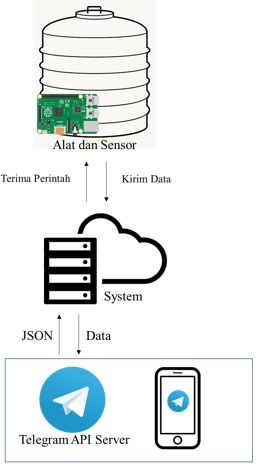Sistem Monitoring dan Kontrol Tangki Air Menggunakan Raspberry Pi Berbasis Bot Telegram
Abstract
Water tanks are often placed at a height to take advantage of the force of gravity so that water can flow optimally. The high position of the water tank is difficult for users to find out the quality and volume of water. Poor water quality such as experiencing turbidity can have a bad impact. So we need a system that can detect turbidity and water volume and can inform users remotely. The technology that can be used is the internet of things. The system built will monitor the turbidity and volume of the user's water tank, as well as control the pump in the form of turning it on and off. The interaction process between users and the system using bots from Telegram. The test results of the system can monitor turbidity and water volume and control the water pump through interaction with users using Telegram bots. The test results show the average speed of the entire system process is 1.48 seconds. The use of Raspberry Pi microcontroller can be used for future system development such as adding cloudy water treatment process features or others. Another development suggestion by adding bots as an interface from other instant messaging applications.
Downloads
References
[2] M. A. Jass and M. Fitri, “PERENCANAAN AWAL JARINGAN PIPANISASI AIR BAKU SECARA GRAVITASI (STUDI KASUS: PENGAMBILAN AIR DARI SUB DAERAH ALIRAN SUNGAI KRUENG INONG UNTUK KEPERLUAN PERUSAHAAN DAERAH AIR MINUM TIRTA DAROY),” J. Tek. SIPIL Univ. Muhammadiyah Aceh, vol. 7, no. Desember, pp. 105–116, 2018.
[3] E. P. Umar, A. Nawir, and A. Nurfalaq, “Pengaruh kondisi geologi lingkungan terhadap potensi air tanah dalam di kota makassar,” J. Geocelebes, vol. 3, no. 1, pp. 13–18, 2019.
[4] Kementrian Kesehatan Republik Indonesia, “PERMENKES RI Nomor 32 Tahun 2017,” Jakarta, 2017.
[5] A. O. Putri, L. Elektronika, J. Fisika, and U. Andalas, “Rancang Bangun Alat Ukur Tingkat Kekeruhan Air Menggunakan Fotodioda Array Berbasis Mikrokontroler ATMega328,” J. Fis. Unand, vol. 7, no. 1, pp. 27–32, 2018.
[6] P. Sethi and S. R. Sarangi, “Internet of Things: Architectures, Protocols, and Applications,” J. Electr. Comput. Eng., vol. 2017, pp. 1–25, 2017.
[7] E. R. Wahyuni, R. W. T. Hartono, and M. Y. Fadhlan, “Sistem Monitoring Kualitas Air Tambak Ikan Melalui Jaringan GSM dan SMS Gateway Menggunakan Smartphone Android,” Pros. 11th Ind. Res. Work. Natl. Semin., pp. 26–27, 2020.
[8] L. A. Gama-Moreno, A. Corralejo, A. Ramirez-Molina, J. A. Torres-Rangel, C. Martinez-Hernandez, and M. A. Juarez, “A design of a water tanks monitoring system based on mobile devices,” Proc. - 2016 Int. Conf. Mechatronics, Electron. Automot. Eng. ICMEAE 2016, pp. 133–138, 2016.
[9] H. R. Iskandar, D. I. Saputra, and H. Yuliana, “Eksperimental Uji Kekeruhan Air Berbasis Internet of Things Menggunakan Sensor DFRobot SEN0189 dan MQTT Cloud Server,” J. Umj, no. Sigdel 2017, pp. 1–9, 2019.
[10] M. I. D. P. Arlyta Dwi Anggraini, “Pengguna Instant Messaging di Indonesia #20,” 2018. [Online]. Available: http://indonesiabaik.id/infografis/pengguna-instant-messaging-di-indonesia-20. [Accessed: 21-Apr-2020].
[11] Telegram, “Bots: An introduction for developers,” Telegram.org. [Online]. Available: https://core.telegram.org/bots. [Accessed: 03-Mar-2020].
[12] I. M. Sukarsa, I. K. G. D. Putra, N. P. Sastra, and L. Jasa, “A New Framework for Information System Development on Instant Messaging for Low Cost Solution,” TELKOMNIKA (Telecommunication Comput. Electron. Control., vol. 16, no. 6, p. 2799, Dec. 2018.
[13] A. Pawar and V. M. Umale, “Internet of Things Based Home Security Using Raspberry Pi,” in 2018 Fourth International Conference on Computing Communication Control and Automation (ICCUBEA), 2018, pp. 1–6.
[14] I. G. A. Darmawan, L. Jasa, and P. Rahardjo, “Rancang Bangun Alat Sebagai Layanan Notifikasi Air Conditioner Yang Rusak Pada Bagian Kompresor,” Maj. Ilm. Teknol. Elektro, vol. 19, no. 2, pp. 211–218, 2020.
[15] I. G. P. M. Eka Putra, I. A. D. Giriantari, and L. Jasa, “Monitoring Penggunaan Daya listrik Sebagai Implementasi Internet of Things Berbasis Wireless Sensor Network,” Maj. Ilm. Teknol. Elektro, vol. 16, no. 3, p. 50, 2017.
[16] N. S. Yamanoor and S. Yamanoor, “High quality, low cost education with the Raspberry Pi,” in 2017 IEEE Global Humanitarian Technology Conference (GHTC), 2017, pp. 1–5.
[17] H. Indonesia, “Email vs. Instant Messaging: Apa Bedanya? Bagaimana jika kelebihan keduanya digabungkan dalam satu aplikasi?,” Medium.com, 2017. [Online]. Available: https://medium.com/hipe-indonesia/email-vs-instant-messaging-apa-bedanya-a678c682d41d. [Accessed: 01-Apr-2020].
[18] K. Nirosha, B. Durga Sri, C. Mamatha, and B. Dhanalaxmi, “Automatic street lights on/off application using IOT,” Int. J. Mech. Eng. Technol., vol. 8, no. 8, pp. 38–47, 2017.
[19] M. Putri, U. Pembangunan, P. Budi, S. A. Lubis, U. Pembangunan, and P. Budi, “Design of Security Tools Using Sensor Light Dependent Resistor ( Ldr ) Through Mobile Phone,” Int. J. Innov. Res. Comput. Commun. Eng. · Novemb. 2018 Cit., no. November, 2018.
[20] A. A. Azman, M. H. F. Rahiman, M. N. Taib, N. H. Sidek, I. A. Abu Bakar, and M. F. Ali, “A Low Cost Nephelometric Turbidity Sensor for Continual Domestic Water Quality Monitoring System,” Proc. - 2016 IEEE Int. Conf. Autom. Control Intell. Syst. I2CACIS 2016, no. October, pp. 202–207, 2016.
[21] A. R. Patkar and P. P. Tasgaonkar, “Object Recognition Using Horizontal Array of Ultrasonic Sensors,” in 2016 International Conference on Communication and Signal Processing (ICCSP), 2016, pp. 0983–0986.
[22] K. Balasubramaniam, N. Raja, and S. Periyannan, “Ultrasonic Waveguide Sensors for Measurements in Process Industries,” in 2018 IEEE SENSORS, 2018, pp. 1–4.


This work is licensed under a Creative Commons Attribution-NonCommercial-NoDerivatives 4.0 International License.

This work is licensed under a Creative Commons Attribution 4.0 International License




